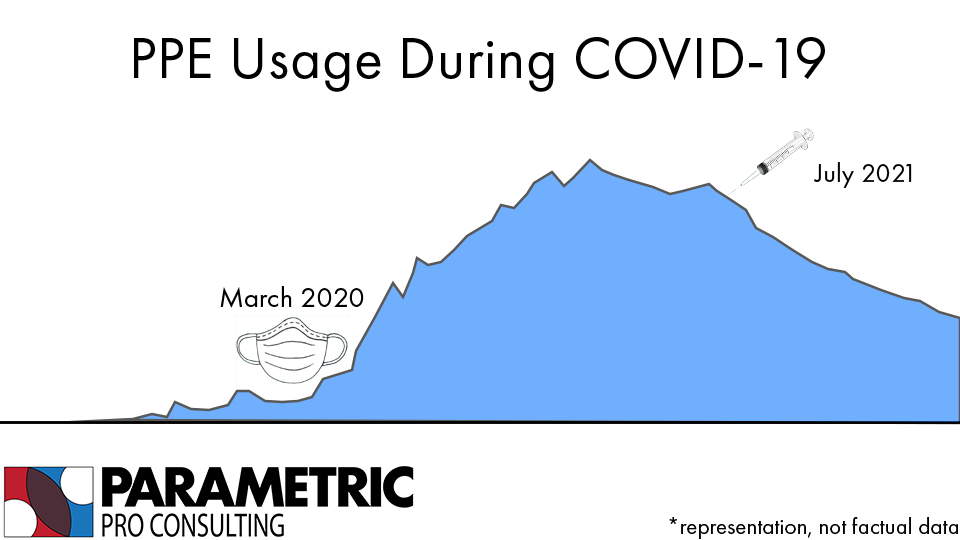Introduction
As you know, Covid-19 has been detrimental to several markets (e.g. retail, tourism, commercial real estate, etc.), but it has also lifted markets to new heights and allowed for innovation in sectors ripe for growth (e.g. construction, real estate development, online education, e-commerce, recreational vehicles, local tourism/staycations).
Of course, some of these new conditions in the market will be fads or trends, and simply dissipate as the world returns to homeostasis, but we believe that some trends will persist and become long-term sustainable business opportunities.
Before exploring the long-term opportunities that we think are worth investing in, we think it’s important for us to note what we think is a short-term trend.
Short Term Trends
Personal Protective Equipment
PPE production has become big business for several manufacturers. As demand exploded at the beginning of the pandemic, manufacturers rushed to scale their facilities for market demand. Now, PPE production has largely dwindled and, due to the structure of the market being perfectly competitive, manufacturers swarmed the marketplace, driving down margins and profits. In addition, when masks and plexiglass screens are no longer required, aggregate demand will shrink.

Food delivery services
In addition to legal and regulatory pressures, food delivery services are not replacing traditional dining and restaurants. It has been shown that if food delivery companies, like Doordash and Uber Eats, had to employ their drivers and provide benefits, they would not be economically viable. In the long-term, the discounts on food and the commission fees that these large firms take from restaurants hemorrhage cash from an already minimal margin business. If we were forced to make a prediction, we think that restaurants who do significant delivery volume will begin to employ delivery drivers for in-house delivery. As conscious consumers become more aware of the threat that delivery services pose to their local restaurants, they will begin to shift their demand towards less harmful means of delivery.
An interesting emerging sector for food delivery services is the ghost kitchen. Ghost kitchens are essentially shared commercial kitchens that have no restaurant to serve. They function like commissary kitchens, which are used for food preparation, but instead of being used for catering services and food trucks, they are used to prepare food for food delivery services. Oftentimes, since they are designed entirely for food delivery services, their operations and finances are organized more efficiently to achieve profitability while paying the commission fees and discounts on foods.
Long-term Opportunities
Real estate
Covid-19 forced global governments to produce massive stimulus for their populations to avoid economic stagnation. According to John Maynard Keynes, lack of consumer spending was the reason why the Great Depression had such a massive effect. He believed that in order to avoid large economic downturns, consumers should save less and spend more, consequently producing more flows of cash throughout the economy. Keynesian economics has been a cornerstone of modern monetary and fiscal policy, which largely drove the decision to produce so much new currency in 2020. Estimates vary, however, most economists believe that around 25% of the United States’ currency was printed in 2020. This massive amount of money being infused into the economy will cause inflation. Governments today do have more tools to control rapid inflation than they did in the 1980s, but we think that they will not be able to maintain the current economic environment.
One of the most popular inflationary hedges is real estate. Tying up cash in real estate is a safe sector to invest in during inflationary periods because as inflation increases so do property values and rents. Relative to other industries, real estate is able to adjust their cash flows easily according to aggregate price increases much more easily (i.e. by raising rents according to inflation).
You may then ask what type of real estate is worth targeting. We think that residential real estate and commercial warehouse space will perform the best in the coming years. As the work-from-home trend begins to become a norm, people will begin to value where they live, and now work, more. From our experience, REITs and real estate asset managers are also continuing to allocate large amounts of capital into residential real estate. These large capital allocators are investing in major primary markets (e.g. Vancouver, Toronto, Calgary) and emerging secondary markets (e.g. Victoria, Halifax, Waterloo). On the other hand, warehouse commercial space is becoming a more desirable commodity as companies begin to understand the advantages of vertical integration that companies, like Amazon, have.
In the next couple of years, being your own landlord will be a major source of value for businesses. Vertical integration has proven to be one of the most tactically effective methods to maximize shareholder value, and we expect many businesses will begin to realize this. If you’re a developer, commercial real estate will continue to be a profitable venture.
Acquisitions
Another byproduct of the Covid-19 monetary policy has been shrinking interest rates and lower cost of capital. This has both stimulated consumer spending and incentivized businesses to perform large transactions. If your company has been looking to make an acquisition, this is a great time to purchase. Debt financing is still extremely attractive and companies who are still operating now have shown that they can withstand heavy market fluctuations.
If you haven’t considered your exit strategy, now may also be a good time. Some key things to do if you’re planning an exit strategy are the following:
Stabilize and maximize EBITDA
Automate systems
Make yourself replaceable (it is challenging to frame your company as an easy acquisition if you’re crucial to the operations)
To better understand how to position your organization towards an exit strategy, check out our blog post on the McKinsey 7-S framework here.
Local supply chains and tourism
Supply chain disruptions were among the most noticeable economic threats that covid-19 posed and subsequently caused. A massive reliance on Chinese manufacturing proved to be a threat to our economic stability. We’ve noticed that consumers are now, more than ever before, valuing locally sourced and manufactured products. Locally produced consumer goods businesses are expected to experience large growth in the coming years. However, some products, such as semiconductors and chemicals, will likely not be moved to local manufacturing, since outsourcing labour provides massive labour cost and technological advantages.
In addition to consumer spending trending towards locally produced goods, consumers are also projected to begin shifting towards a heavier income allocation of local tourism/entertainment. This summer alone, boat sales are expected to set records and motorcycles are selling better than they have in decades. In addition to this surge in demand for recreational vehicles, camping supply chains are throttled and having a difficult time trying to meet consumer demands. Covid-19 has forced consumers to look at their backyards, rather than other continents, when trying to plan for vacations. Of course, there will be some “revenge travel”, where consumers will make up for the missed travel, but we believe as environmental concerns regarding travel continue to develop and real median wages continue to stagnate, consumers will be forced to limit the scale of their travels.
Online Education
Prior to covid-19, online education was already a high-growth industry with large prospects for scaling and dynamic content delivery. Now, however, the pandemic has catalyzed the industry and every form of traditional education has had to move to online mediums. In addition, the proliferation of micro certifications and online learning platforms has forced traditional educational institutions to adapt to the market’s preferences. It is expected that, in the next couple of years, media giants will begin to pivot some of their product lines to educational products and more private sector organizations will enter the online education space.
Google has already entered the education space. In collaboration with Coursera, they are currently offering classes in Data Analytics, Project Management, UX Design, IT support, and IT automation. They claim that each of their classes is equivalent to a 4-year degree in the subject. This new influx of competition into a relatively stagnant market will force traditional institutions to innovate and offer their “services” at market prices.
From a company’s perspective, we think digitizing training materials and offering certifications both internally and externally can be a great promotional tool for brand awareness and time investment from prospective employees.
Construction/ Heavy Industry Innovation
Construction has largely remained the same over the past 50 years. Automation has largely been adopted by mass manufacturing, however, construction and other heavy industry sectors still rely heavily on manual labour. Prefabrication developments have been built over the past 10 years, but they have not been implemented to their full potential. Given the construction site is within roughly 200 kilometers of the prefabrication facility, prefabrications have an absolute economic advantage. They reduce the labour needed on site and provide economies of scale for framing and finishing.

One of the cornerstones of the 4th Industrial Revolution is the proliferation of AI applications. AI has already been applied to consumer goods; however, now that it has proved its utility, it is going to be widely applied to heavy industry to automate processes and ensure proper maintenance.
In addition to heavy industrial companies upgrading their systems and equipment, automation consultants will become high in demand. Understanding the growth in the industry and creating strong relationships will yield massive value. Automation is going to occur, getting ahead of the exponential growth will be key to remain competitive.
Conclusion
In conclusion, while Covid-19 has created several opportunities for people willing to make some riskier moves, it has also manufactured some short-term bubbles to watch out for. From food delivery to protective equipment to automated construction manufacturing, the world is changing, and those who can get ahead of new waves will come out ahead.
If you have a potential opportunity and need some help getting it off the ground, book a free consultation with us and we can work together to bring your idea to fruition.
If you liked this post, please consider sharing it with your network!
Check out our Business Strategy Frameworks and Marketing Starter Kit guides for more useful tools.
Are you interested in the consulting industry? Parametric Pro Consulting Foundations offers more in-depth knowledge on this article as well as several other topics to prepare you for a career in business and consulting. Check it out here!
